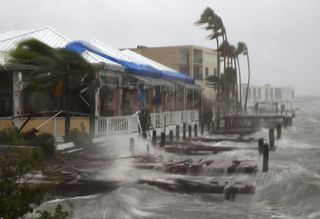Hurricane Matthew: Why Are Storm Surges So Deadly?

Hurricanes can be deadly, but it's typically not the wind from these powerful storms that causes the highest number of fatalities. Rather, storm surges caused by hurricanes are "often the greatest threat to life and property from a hurricane," according to the National Hurricane Center (NHC), which posted warnings about storm surges expected from Hurricane Matthew this week.
But what are storm surges, and why are they so deadly?
Storm surges occur when a storm's winds drive the water's surface to higher-than-normal levels. This increase in the water's height can lead to coastal flooding, which has already happened along parts of the Florida coast, the NHC reported. [Hurricane Matthew Photos: See How the Monster Storm Evolved]
To understand a storm surge, imagine a giant hurricane churning in the ocean near a coastline. The center of a hurricane has extremely low pressure, which causes the ocean water there to bulge upward like a balloon.
In addition, the hurricane's winds are constantly pushing the water toward the shore, said James Done, science lead for the Capacity Center for Climate and Weather Extremes at the National Center for Atmospheric Research in Boulder, Colorado.
Eventually, the displaced water, both from the hurricane's inward bulge and relentless winds, can spill onto land, causing extensive flooding, Done said.
However, the height of the surge depends on several factors, including whether the continental shelf is steep or shallow, the NHC said. A shallow slope will often produce a greater storm surge than a steep shelf. For instance, a Category 4 storm hitting Louisiana's wide and shallow shelf would only produce a 20-foot (6 meters) storm surge, while the same hurricane in Miami Beach, Florida, would only produce an 8- or 9-foot-tall (2.4 or 2.7 m) surge, the NHC said.
Sign up for the Live Science daily newsletter now
Get the world’s most fascinating discoveries delivered straight to your inbox.
Furthermore, the sizes of storm surges can be influenced by changes in the storm's intensity, the forward speed and radius of the hurricane, the angle with which the hurricane approaches the coast and the coastline's unique landscape, the NHC reported.
Water surging onto shore often takes people by surprise. At least 1,500 people died during Hurricane Katrina in 2005, largely because of flooding caused by storm surges, the NHC said.
"You have all of this water coming very fast," said Suzana Camargo, a research professor of ocean and climate physics at the Lamont-Doherty Earth Observatory at Columbia University in New York City. "People aren't ready for it and don't have anywhere to go. For instance, if your house is being flooded, where do you go?" [Tropical Storms and Hurricanes of 2016 (Photos)]
Once a storm surge floods the coast, its heavy, rushing waves, which weigh 1,700 lbs. per cubic yard (4,150 kilograms per cubic meter), can cause damage to roads and buildings, according to the NHC.
In Florida, the Category 3 Hurricane Matthew has already caused a storm surge of 3.11 feet (1 m) at Fernandina Beach, according to a tidal gauge, the NHC said.
Moreover, "there is a danger of life-threatening inundation during the next 36 hours along the Florida northeast coast, the Georgia coast, the South Carolina coast, and the North Carolina coast from Cocoa Beach, Florida, to Cape Fear, North Carolina," the NHC said in a 2 p.m. ET update posted today (Oct. 7).
In a tweet this afternoon, WTLV newscaster Katie Jeffries showed the extensive flooding that's already happening at Jacksonville Beach, Florida, writing, "This just speaks for itself #JaxBeach #FCNStorm."
However, storm surges should not be confused with storm tides, which happen when an enormous tide combines with a storm surge, the NHC said. Storm tides, which flooded New York during Hurricane Sandy in 2012, can reach up to 20 feet (6 m) in height if a surge combines with a high tide, the center said.
Original article on Live Science.

Laura is the archaeology and Life's Little Mysteries editor at Live Science. She also reports on general science, including paleontology. Her work has appeared in The New York Times, Scholastic, Popular Science and Spectrum, a site on autism research. She has won multiple awards from the Society of Professional Journalists and the Washington Newspaper Publishers Association for her reporting at a weekly newspaper near Seattle. Laura holds a bachelor's degree in English literature and psychology from Washington University in St. Louis and a master's degree in science writing from NYU.
Most Popular


